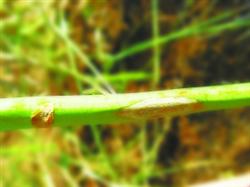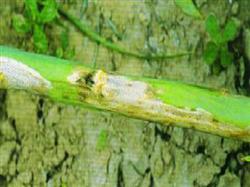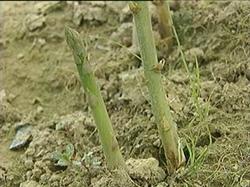Symptoms and control methods of asparagus stem blight

Asparagus is a kind of valuable vegetable with excellent taste. With the continuous improvement of people's living standards, the demand for asparagus in domestic and foreign markets is increasing. Because of its strong drought tolerance, asparagus is especially suitable for planting in Tianjin. However, with the increase of planting years and the expansion of the area, the occurrence of stem blight is becoming more and more serious, and the incidence of some plots is about 80%, even the whole field is destroyed, which seriously affects the healthy development of asparagus planting industry. Therefore, it is particularly important to detect the symptoms of the disease as soon as possible and take comprehensive control measures to give priority to prevention and cure both the symptoms and the root causes. The main results are as follows: 1. the disease spot mainly occurs on the stem and branch, which occurs first on the face of the tender stem, which is milky white at first, then gradually expands into a small wet spot in the shape of a spindle or fusiform, and gradually turns brown in the center. Sunken, scattered small black spots (that is, conidium). When the disease spot is serious, it grows all over the plant, and when the disease spot surrounds the stem for a week, the whole plant dries up and dies. 2. Control methods 1. Select disease-resistant varieties and do a good job in seed treatment. At present, Mary Washington 500 introduced from abroad is more resistant to stem blight. For the selected seeds, soaking seeds in warm soup or medicament treatment should be carried out before sowing. The seeds can be soaked in 50 ℃ warm water 10min, and pay attention to pour water before putting the seeds, and constantly stir, so that the seeds are heated evenly. Fumishuang and other agents can also be used to treat seeds, which has a better germicidal effect and can reduce the occurrence of diseases. 2. Reasonable selection of asparagus land is easy to occur in places such as heavy soil, low-lying mat, close to orchards and paddy fields, while high topography, good drainage and ventilation of loam or sandy soil, clean environment and less disease. 3. Reasonable close planting in Tianjin is more suitable for wide row close planting (row spacing 180cm × plant spacing 50cm). Excessive density or improper intercropping within 2 years after planting will cause mutual concealment and form a hot and humid microclimate, which is conducive to the occurrence of diseases. Special emphasis is placed on the prohibition of intercropping any crops in the bamboo shoot field. 4. Timely and reasonable fertilization and drainage asparagus has a large growth and a large amount of fertilizer, so timely fertilization should be applied, especially sufficient base fertilizer. Applying organic fertilizer 5000kg per 667m2, depending on the seedling condition, applying chemical fertilizer. Asparagus is a phosphorus-loving and potassium-loving crop, so we should be careful not to apply nitrogen fertilizer to ensure the nutritional needs, robust growth and improve the disease resistance of asparagus. Timely drainage is needed in the rainy season to reduce the humidity of the bamboo shoot field and reduce the spread of germs. 5. The occurrence of weed control by ploughing not only affects the plant growth, but also aggravates the spread of the disease. Timely ploughing and weeding to remove dead stems and leaves is conducive to ventilation and light transmission and reduce the occurrence of diseases. 6. in order to overwintering and prevent winter or spring, we should do a good job in clearing the land. All the remaining stems and leaves on the ground should be cleared out of the bamboo shoot field and burned to reduce the source of bacteria. Spraying soil or stem disk with 50% carbendazim 1000-1500 times or 70% methyl thiophanate 1000-UV 1500 times before and after April can greatly reduce the source of primary infection, control the disease as soon as possible, and control as soon as possible. 7. During the peak period of the disease, adhere to the chemical control of high temperature and high humidity in the rainy season from July to August in Tianjin, which is the peak period of asparagus stem blight, and must be sprayed every other week. The commonly used agents are: 75% chlorothalonil 600x solution, 80% Dyson zinc 600m Mel 800x solution, and 70% methyl topiramate 1000 fold solution. Because the stem maturity affects its susceptibility, the disease first occurs on the tender stem, so spraying should be targeted, with the newly unearthed tender stem as the main goal, in order to strive for a better control effect.
- Prev

Technical points of harvesting asparagus with mother stem
Asparagus stem blight is a destructive disease, known as "asparagus cancer". Once you get stem blight, the yield will be reduced, and if it is heavy, the garden will be destroyed and the harvest will be destroyed, resulting in huge losses to the majority of bamboo shoot farmers. Affected by SARS in 2003, the price of asparagus is low, many bamboo shoot farmers give up management, the occurrence of stem blight is more serious, at the same time asparagus field.
- Next

Occurrence and control of stem rot of asparagus
1. Symptom characteristics asparagus stem rot mainly harms young bamboo shoots. The young bamboo shoots may be damaged after they are unearthed, and the young stems appear water-like amorphous disease spots, which expand around the stem, resulting in stem tissue disintegration and decay, resulting in the death of young bamboo shoots. If the disease is light, even if it does not wither and die, its growth potential is greatly reduced, the aboveground stems and leaves are weak, the young stems are weak, and the yield.
Related
- Where is it suitable to grow horseradish in China? it is expected to see the middle altitude horseradish in Alishan.
- How to prevent tomato virus disease reasonably? (Control methods included)
- Many people like to plant towel gourd on the balcony. What are the main points of this method and management?
- What crops can chili peppers be mixed with?
- Fertilization techniques and matters needing attention in Tomato
- What are the grafting techniques for peach seedlings in spring?
- Harm and control methods of root swelling disease of Chinese cabbage
- What are the pests of sweet potatoes? How to prevent and cure it?
- Symptoms, causes and Control methods of navel Rot in Tomato
- The cause of "Cucumber rotten bibcock" in Farmers' planting Cucumber and its Control Plan

